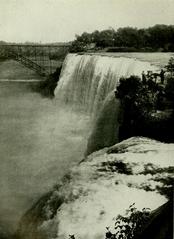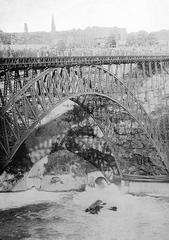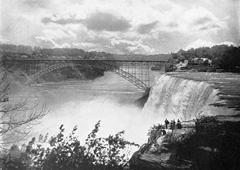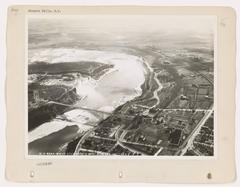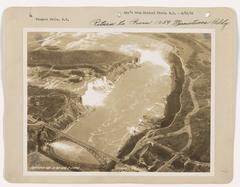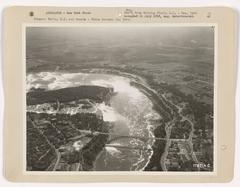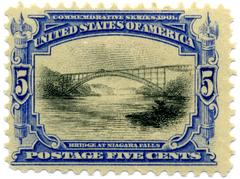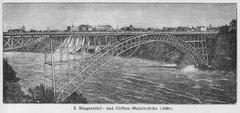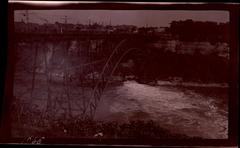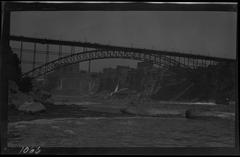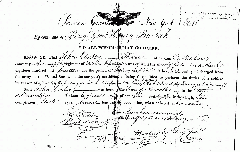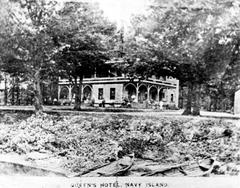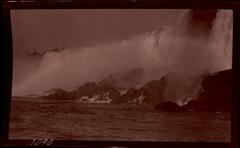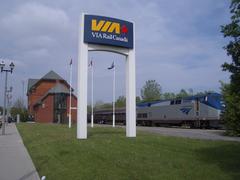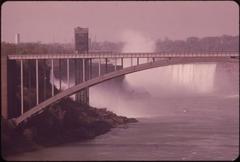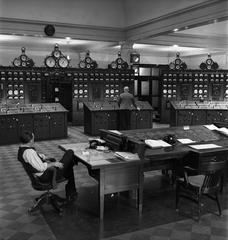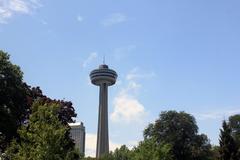
Honeymoon Bridge Visiting Hours, Tickets, and Niagara Falls Historical Sites Guide
Date: 15/06/2025
Introduction
The Honeymoon Bridge, also known as the Upper Steel Arch Bridge, once spanned the Niagara River between Niagara Falls, Ontario, and Niagara Falls, New York. Renowned for both its engineering brilliance and its role as a romantic gateway, the bridge became a symbol of Niagara Falls’ allure as a premier destination for newlyweds and tourists. Officially opened in 1898 and dramatically lost to the river in 1938 due to an unprecedented ice jam, the bridge’s story is one of innovation, cultural significance, and the constant interplay between human ambition and nature’s power. This guide provides a detailed account of the Honeymoon Bridge’s history, cultural impact, and practical information for visitors seeking to explore its legacy and the surrounding Niagara Falls historical sites.
For in-depth history and visitor resources, consult sources such as Niagara Falls Info, Yahoo News, and Niagara Falls Live.
Table of Contents
- Introduction
- Origins and Construction of the Honeymoon Bridge
- Cultural Significance and the “Honeymoon Bridge” Name
- Engineering Challenges and Collapse
- Aftermath: The Birth of the Rainbow Bridge
- Visiting the Honeymoon Bridge Site Today
- Frequently Asked Questions (FAQ)
- Rainbow Bridge: Hours, Tickets, and Attractions
- Summary and Traveler Tips
- References
Origins and Construction of the Honeymoon Bridge
The Honeymoon Bridge, officially the Upper Steel Arch Bridge, was constructed from 1897 to 1898 by the Pencoyd Bridge Company of Philadelphia. Designed by engineer Leffert L. Buck, it became the world’s largest steel arch bridge at the time, with a span of 840 feet (256 meters) (Niagara Falls Info). The bridge featured a two-hinged steel arch anchored deep within the Niagara Gorge, supporting electric car tracks, carriage lanes, and pedestrian walkways.
Replacing an earlier suspension bridge, the structure quickly gained prominence as both a vital transportation link and a favored destination for those seeking panoramic views of the American and Horseshoe Falls.
Cultural Significance and the “Honeymoon Bridge” Name
Niagara Falls has long been celebrated as a romantic destination, and the bridge’s popularity among newlywed couples led to its affectionate nickname: the “Honeymoon Bridge.” The spectacular views and unique cross-border connection made it a memorable feature of the Niagara experience (Niagara Action, The Bridal Tip). The bridge replaced a suspension bridge that was relocated to become the Queenston-Lewiston Bridge.
Engineering Challenges and Collapse
Natural Forces and Early Signs of Vulnerability
From its opening, the Honeymoon Bridge contended with the formidable forces of the Niagara River, particularly winter ice floes. In 1899, ice accumulation reached up to 24 meters (80 feet) at the abutments, forcing engineers to blast ice and reinforce the structure with protective stone walls (Yahoo News). The bridge also swayed under high winds and crowds, prompting additional bracing.
The Dramatic Collapse of 1938
On January 23, 1938, a powerful windstorm pushed massive ice sheets over Niagara Falls, causing a severe jam beneath the bridge. Despite previous reinforcements, the relentless ice pressure compromised the structure. Authorities closed the bridge, averting casualties. On January 27, at 4:20 p.m., the bridge’s American abutment failed, sending the entire span crashing into the gorge below (Yahoo News, An Engineer’s Aspect). Debris was later dynamited and cleared.
Aftermath: The Birth of the Rainbow Bridge
The Honeymoon Bridge’s collapse underscored the power of nature and spurred the construction of the Rainbow Bridge, which opened in 1941 on the same site. The new bridge incorporated lessons learned from the disaster, featuring improved foundations and engineering to withstand future ice jams (Active History).
Visiting the Honeymoon Bridge Site Today
Though the original bridge is gone, its legacy is preserved through historical markers, interpretive plaques, and the enduring presence of the Rainbow Bridge.
Visitor Information
- Location: The Rainbow Bridge stands just downstream of the original Honeymoon Bridge site.
- Accessibility: The bridge and nearby parks are fully accessible for pedestrians, cyclists, and vehicles.
- Hours: Rainbow Bridge is open 24 hours a day, seven days a week for pedestrians and vehicles. Customs hours for border crossing may vary (Niagara Falls Live), but the bridge itself is always open.
Nearby Attractions
- Niagara Falls State Park (USA): The oldest state park in the U.S., with direct falls access.
- Queen Victoria Park (Canada): Beautiful gardens and falls viewing areas.
- Niagara Falls History Museum: Exhibits detailing the Honeymoon Bridge and regional history (Niagara Falls Tourism).
- White Water Walk and Niagara Parks Power Station: Interpretive trails and historic engineering sites.
- Clifton Hill: Entertainment, dining, and family attractions (Clifton Hill).
Travel Tips
- Travel Documents: A valid passport (or appropriate travel card) is required for border crossing.
- Best Visiting Times: Spring through early fall for mild weather and vibrant scenery; winter for dramatic ice formations.
- Safety: Walking on ice is prohibited. Stay on designated paths and walkways.
- Guided Tours: Many tours cover the history of the Honeymoon and Rainbow Bridges.
- Photography: The Rainbow Bridge provides exceptional photo opportunities of both falls and the city skyline.
Frequently Asked Questions (FAQ)
Q: Does the Honeymoon Bridge still exist?
A: No, it collapsed in 1938 due to ice pressure and was removed. Its legacy lives on through historical markers and the Rainbow Bridge.
Q: Can I visit the original Honeymoon Bridge site?
A: While the bridge is gone, you can visit the Rainbow Bridge and see historical markers commemorating the original site.
Q: What are Rainbow Bridge visiting hours?
A: Open 24/7 for pedestrians and vehicles; customs and border crossing hours may vary.
Q: Are there fees to cross the Rainbow Bridge?
A: Yes, a pedestrian toll is $1.00 USD or $1.25 CAD when entering the U.S.; vehicle tolls are $6.00 USD or $8.50 CAD when entering Canada. No tolls are charged for returning (Niagara Falls Live).
Q: Is the Rainbow Bridge accessible?
A: Yes, it offers ramps and smooth walkways.
Rainbow Bridge: Hours, Tickets, and Attractions
Location and Access
The Rainbow Bridge connects downtown Niagara Falls, Ontario, with Niagara Falls, New York. It is easily accessed from Niagara Parkway and within walking distance to Clifton Hill (Wikipedia, Clifton Hill).
Visiting Hours and Fees
- Open: 24 hours a day, year-round.
- Pedestrian Toll: $1.00 USD or $1.25 CAD (coins only, payable entering the U.S.).
- Vehicle Toll: $6.00 USD or $8.50 CAD when entering Canada.
- Cyclists: Welcome; bike racks available (Niagara Falls Live).
Historical Markers
Plaques and interpretive displays at the Rainbow Bridge and Queen Victoria Park recount the rise and fall of the Honeymoon Bridge and the evolution of cross-border infrastructure (Go Niagara Tours).
Photo Opportunities
The Rainbow Bridge’s walkway offers panoramic views of the American Falls, Bridal Veil Falls, Horseshoe Falls, and the Niagara Gorge. Early morning and dusk provide optimal lighting. Fireworks over the falls can often be enjoyed from the bridge during summer months (City Experiences, Niagara Falls Tickets Tours).
Amenities and Accessibility
- Dining & Shopping: Numerous restaurants and duty-free shops are located at both bridge ends (Niagara Falls Live).
- Wheelchair Access: Fully accessible with ramps and smooth walkways.
- Nearby Attractions: Journey Behind the Falls, Niagara City Cruises, Niagara SkyWheel, and more (Destinationless Travel).
Summary and Traveler Tips
The Honeymoon Bridge’s story is one of ambition, romance, and the unpredictability of nature. Though the original structure no longer stands, its memory endures in the Rainbow Bridge and the surrounding historical sites. Today, visitors can traverse the Rainbow Bridge, enjoy sweeping views of the falls, explore museums and interpretive centers, and learn about the rich history that shaped this iconic region. To get the most from your visit:
- Carry proper travel documentation for border crossing.
- Visit in spring, summer, or early fall for the best weather.
- Take advantage of guided tours for deeper historical insights.
- Explore nearby attractions like Queen Victoria Park, Niagara Falls History Museum, and Clifton Hill.
- Check live border wait times and bring coins for pedestrian tolls.
For more travel tips and updates, download the Audiala app and follow Niagara Falls’ official channels.
References
- Niagara Falls Info
- Yahoo News
- Niagara Falls Live
- Active History
- Niagara Falls Tourism
- Clifton Hill
- Go Niagara Tours
- Hill City Bride
- The Bridal Tip
- Destinationless Travel
- City Experiences

